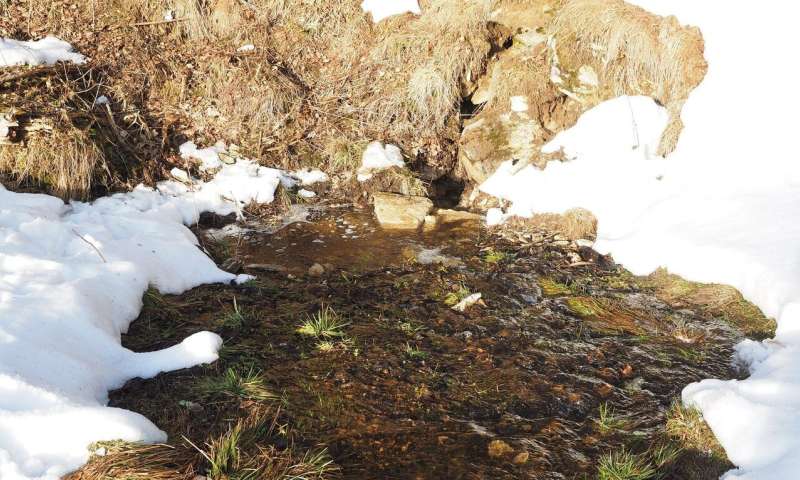Model estimates subsidence risks across the globe
by Bob Yirka , Phys.org

Credit: Pixabay/CC0 Public Domain
An international team of researchers has created a model that can be used to make estimates about the degree of subsidence risk for different parts of the world. In their paper published in the journal Science, the group describes the factors that went into creating their model, and what it showed.
Subsidence occurs when the ground sinks due to material beneath the surface being extracted. In this new effort, the researchers focused on subsidence due to water removal. Prior research has shown that several locations around the globe are already suffering from subsidence problems due to water extraction. Officials in Indonesia, for example, are looking to move the capital of that country (Jakarta) to Borneo. The ground in Jakarta has sunk so much that the government is worried that it will soon fill with ocean water. Subsidence can be less dramatic but still just as problematic—sinking ground can lead to cracks in foundations making buildings unstable, for example.
Subsidence has become problematic in areas of high population or heavy farming, both of which lead to massive amounts of water being pumped from underground reservoirs. As a reservoir is drained, there is no longer anything to support the ground above and so it sinks. Subsidence occurs in two main ways, long slow drops in ground level, and faster drops that are frequently seen as sinkholes.
In this new effort, the researchers sought to create a model that could be used to forecast subsidence in different parts of the world. To meet that goal, they first obtained data describing subsidence that has already occurred or that is occurring now. They then obtained data from different sources describing geology, climatic conditions, susceptibility to flooding, drought and human activities such as pumping water from the ground to supply cities or large farming operations.
They then used the data they had obtained to create a model that could be used to estimate the risk for individual areas around the globe and for whole regions. They next used their model to make predictions for areas that they could compare with real-world results as a way to test the accuracy of the model. In so doing, they found their model to be 94 percent accurate on average. They then used their model to create maps of the world showing which parts were estimated to be at greatest risk of sinking and found that approximately one-fifth of the world's population was living in at-risk areas—the vast majority of which are in Asia.
Explore furtherChanges in subsistence hunting threaten local food security
An international team of researchers has created a model that can be used to make estimates about the degree of subsidence risk for different parts of the world. In their paper published in the journal Science, the group describes the factors that went into creating their model, and what it showed.
Subsidence occurs when the ground sinks due to material beneath the surface being extracted. In this new effort, the researchers focused on subsidence due to water removal. Prior research has shown that several locations around the globe are already suffering from subsidence problems due to water extraction. Officials in Indonesia, for example, are looking to move the capital of that country (Jakarta) to Borneo. The ground in Jakarta has sunk so much that the government is worried that it will soon fill with ocean water. Subsidence can be less dramatic but still just as problematic—sinking ground can lead to cracks in foundations making buildings unstable, for example.
Subsidence has become problematic in areas of high population or heavy farming, both of which lead to massive amounts of water being pumped from underground reservoirs. As a reservoir is drained, there is no longer anything to support the ground above and so it sinks. Subsidence occurs in two main ways, long slow drops in ground level, and faster drops that are frequently seen as sinkholes.
In this new effort, the researchers sought to create a model that could be used to forecast subsidence in different parts of the world. To meet that goal, they first obtained data describing subsidence that has already occurred or that is occurring now. They then obtained data from different sources describing geology, climatic conditions, susceptibility to flooding, drought and human activities such as pumping water from the ground to supply cities or large farming operations.
They then used the data they had obtained to create a model that could be used to estimate the risk for individual areas around the globe and for whole regions. They next used their model to make predictions for areas that they could compare with real-world results as a way to test the accuracy of the model. In so doing, they found their model to be 94 percent accurate on average. They then used their model to create maps of the world showing which parts were estimated to be at greatest risk of sinking and found that approximately one-fifth of the world's population was living in at-risk areas—the vast majority of which are in Asia.
Explore furtherChanges in subsistence hunting threaten local food security
More information: Gerardo Herrera-García et al. Mapping the global threat of land subsidence, Science (2020). DOI: 10.1126/science.abb8549
Journal information: Science
© 2021 Science X Network
17 shares
No comments:
Post a Comment